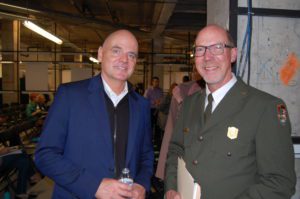Ideas Unlocked at Public Meeting on Canal Plans
By • November 7, 2017 0 492

Some 150 persons concerned about the decline of the historic C&O Canal, an essential part of Georgetown’s identity for more than 180 years, attended a public meeting Nov. 2 to share ideas and comments about the plans for its renewal.
The canal was a highly traveled working waterway in the 1800s. Now, the once state-of-the-art locks, engineered walls and working towpaths have deteriorated. “There is no longer a mule-drawn canal boat to add color to Georgetown’s historic charm and there are limited opportunities to celebrate nature, art, culture and the community along the mile of canals in historic Georgetown,” states Georgetown Heritage, an organization founded to “breathe new life into the C&O Canal through Georgetown.”
In January of 1971, the area became a national park, one of the few that is partly located in an urban environment like Georgetown. Its refurbishment falls under the National Historic Preservation Act.
A master plan developed by Georgetown Heritage, the National Park Service and the Georgetown Business Improvement District would restore the stone structures of the canal walls, improve the towpaths and bridges and add seating, water fountains and lighting along the canal’s public areas, according to Alison Greenberg, executive director of Georgetown Heritage.
 At the second of three public meetings to gather public written comments about alternative design concepts, required by the National Environmental Policy Act, expanded plans were presented by Kevin Brandt, superintendent of the C&O Canal National Historical Park, and designer James Corner. The project area has been newly defined to include the portion of Rock Creek Park from Lock 1 to Mile Post 0. This would make a seamless connection between the two areas, according to Brandt.
At the second of three public meetings to gather public written comments about alternative design concepts, required by the National Environmental Policy Act, expanded plans were presented by Kevin Brandt, superintendent of the C&O Canal National Historical Park, and designer James Corner. The project area has been newly defined to include the portion of Rock Creek Park from Lock 1 to Mile Post 0. This would make a seamless connection between the two areas, according to Brandt.
In addition, from feedback garnered at the first public planning meeting in June, additional landscaping and gateway designs were incorporated. These include areas of serenity as well as small areas for music and public programs that “highlight the canal’s diversity of stories that evoke the past and celebrate the present,” according to Greenberg.
Following the formal presentation by Brandt, attendees shifted between four planning stations to ask detailed questions and prepare comments about four aspects of the refurbishment plan: the crossings, the landscapes, the locks and the gates.
Dec. 11 marks the end of the comment period. Comments to be incorporated into the final concepts document can be submitted electronically or postmarked on or before that date. For more information, and to comment, visit parkplanning.nps.gov. An environmental assessment is to be prepared by next spring.

